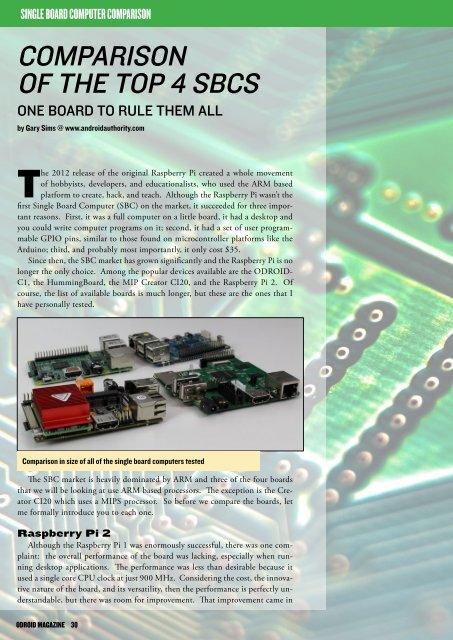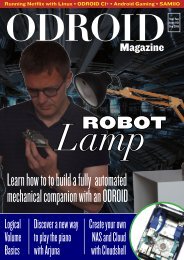You also want an ePaper? Increase the reach of your titles
YUMPU automatically turns print PDFs into web optimized ePapers that Google loves.
SINGLE BOARD COMPUTER COMPARISON<br />
Comparison<br />
of THE Top 4 SBCs<br />
ONE BOARD TO RULE THEM ALL<br />
by Gary Sims @ www.androidauthority.com<br />
The 2012 release of the original Raspberry Pi created a whole movement<br />
of hobbyists, developers, and educationalists, who used the ARM based<br />
platform to create, hack, and teach. Although the Raspberry Pi wasn’t the<br />
first Single Board Computer (SBC) on the market, it succeeded for three important<br />
reasons. First, it was a full computer on a little board, it had a desktop and<br />
you could write computer programs on it; second, it had a set of user programmable<br />
GPIO pins, similar to those found on microcontroller platforms like the<br />
Arduino; third, and probably most importantly, it only cost $35.<br />
Since then, the SBC market has grown significantly and the Raspberry Pi is no<br />
longer the only choice. Among the popular devices available are the <strong>ODROID</strong>-<br />
C1, the HummingBoard, the MIP Creator CI20, and the Raspberry Pi 2. Of<br />
course, the list of available boards is much longer, but these are the ones that I<br />
have personally tested.<br />
Comparison in size of all of the single board computers tested<br />
The SBC market is heavily dominated by ARM and three of the four boards<br />
that we will be looking at use ARM based processors. The exception is the Creator<br />
CI20 which uses a MIPS processor. So before we compare the boards, let<br />
me formally introduce you to each one.<br />
Raspberry Pi 2<br />
Although the Raspberry Pi 1 was enormously successful, there was one complaint:<br />
the overall performance of the board was lacking, especially when running<br />
desktop applications. The performance was less than desirable because it<br />
used a single core CPU clock at just 900 MHz. Considering the cost, the innovative<br />
nature of the board, and its versatility, then the performance is perfectly understandable,<br />
but there was room for improvement. That improvement came in<br />
<strong>ODROID</strong> MAGAZINE 30



